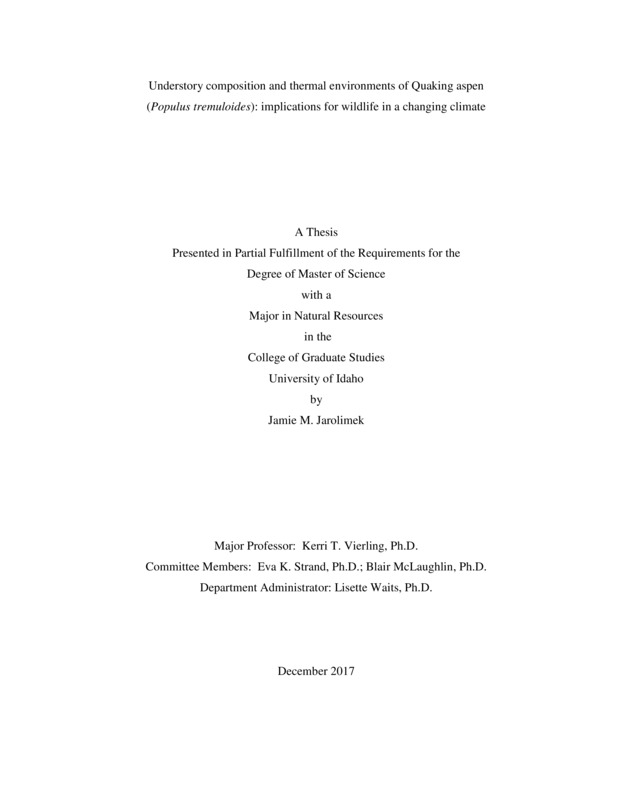Understory composition and thermal environments of Quaking aspen (Populus tremuloides): implications for wildlife in a changing climate
Jarolimek, Jamie. (2017-12). Understory composition and thermal environments of Quaking aspen (Populus tremuloides): implications for wildlife in a changing climate. Theses and Dissertations Collection, University of Idaho Library Digital Collections. https://www.lib.uidaho.edu/digital/etd/items/jarolimek_idaho_0089n_11087.html
- Title:
- Understory composition and thermal environments of Quaking aspen (Populus tremuloides): implications for wildlife in a changing climate
- Author:
- Jarolimek, Jamie
- Date:
- 2017-12
- Keywords:
- microclimate occupancy Populus tremuloides tree cavity TWI understory composition
- Program:
- Natural Resources
- Subject Category:
- Natural resource management; Climate change; Forestry
- Abstract:
-
Climate predictions for the west predict warmer and drier environments in the future. I studied how understory composition and cavity temperatures in quaking aspen (Populus tremuloides; hereafter referred to as aspen) might change as a function of changing climates. We sampled 47 aspen stands and characterized understory composition. Results suggest that some plant species are more indicative of different aspen successional stages and were strongly associated with aspect and TWI (topographic wetness index). Aspen trees characteristics [diameter at breast height (DBH), canopy cover, orientation] and ambient temperature influenced maximum temperatures in tree cavities. Cavity microclimates can provide physiological advantages for optimal embryonic development (between 36°C and 40°C) but embryo mortality might occur at temperatures of > 40°C after a minimum of an hour of exposure. Approximately 13 % of the cavities were between 36°C - 40°C for a least one hour and ~ 8% were in this temperature range for more than an hour. A small proportion of cavities exceed temperatures above 40°C for at least an hour (<5%). Understanding the factors influencing tree cavities and understory composition, which supports a myriad of wildlife, can have broad implications in the context of changing climates.
- Description:
- masters, M.S., Natural Resources -- University of Idaho - College of Graduate Studies, 2017-12
- Major Professor:
- Vierling, Kerri T
- Committee:
- Strand, Eva K; McLaughlin, Blair
- Defense Date:
- 2017-12
- Identifier:
- Jarolimek_idaho_0089N_11087
- Type:
- Text
- Format Original:
- Format:
- application/pdf
- Rights:
- In Copyright - Educational Use Permitted. For more information, please contact University of Idaho Library Special Collections and Archives Department at libspec@uidaho.edu.
- Standardized Rights:
- http://rightsstatements.org/vocab/InC-EDU/1.0/

